
The heatpipe cooling system is like nothing we've seen before in a case. Four large heatipes are strapped to the CPU by way of a large two-piece contact plate that secures to the motherboard using adhesive nuts that attach on the underside. Sprung screws then pass through the contact plate, much like a CPU waterblock, and clamp down into the nuts.
Streacom seems to negate to mention the socket types it's compatible with, but it comes with Intel and AMD mounts, the latter being compatible with Socket AM2 upwards, while the Intel plate can deal with LGA775, LGA1156 and LGA1155. The trick is lining up four heatpipes, each of which needs to be caked in thermal paste and then also secured to the case by way of two aluminium mounts, with two pointing one way and two the other.
Admittedly this proved a tad frustrating, but while we heard of a few horror stories with other Streacom cases and the heatpipe cooler not being compatible, the one in the ST-FC5S EVO WS is actually adjustable, so other than huge VRM heatsinks getting in the way, it's highly unlikely you'll have issues. Before securing the mounting plates on the case and contact plate, the heatsinks are free to move in and out, while the side plates can be relocated several inches back and forth along the side of the case so lining everything up is relatively straightforward.
With half the case and our hands smeared in thermal paste, we eventually nailed it and after a clean-up, the fully-built heatpipe cooler does look fantastic. Someone's clearly spent a great deal of time ensuring both maximum heat dissipation and aesthetics are accounted for, and we think they've done a great job.
Power is likely to add a bit to your HTPC-build bill as you're not able to use any kind of fan-assisted PSU. At the time of writing, OCuK offers a Streacom 150W nano PSU and AC adaptor for around £77, which should be more than enough for a Core i3 and three hard disks. The PSU comes with a plug-in cable that offers two SATA connectors, a 4-pin molex connector and a 4-pin EPS 12V connector.
A final scoot round the case and we just needed to attach the PSU. This includes a long female cable that screws into a hole at the rear to meet the AC adaptor. This sits next to the single expansion slot, which is rotated 90 degrees due to the case being severely vertically challenged. As such you'll need a riser card or cable if you intend to use a TV tuner card for example.
There's obviously nothing in the way of cable routing, so the only option left is to tuck things out of the way. Airflow is strangely not a concern, with the conductive properties of the case hopefully dealing with this for you. even so, it makes sense to keep your hard disks as clear from clutter as possible so they don't cook themselves. Owners of tall RAM DIMMS will likely have to invest in new memory too - there's only a centimetre or so clearance above the standard DIMM PCB.
Click to enlarge
Streacom seems to negate to mention the socket types it's compatible with, but it comes with Intel and AMD mounts, the latter being compatible with Socket AM2 upwards, while the Intel plate can deal with LGA775, LGA1156 and LGA1155. The trick is lining up four heatpipes, each of which needs to be caked in thermal paste and then also secured to the case by way of two aluminium mounts, with two pointing one way and two the other.
Click to enlarge
Admittedly this proved a tad frustrating, but while we heard of a few horror stories with other Streacom cases and the heatpipe cooler not being compatible, the one in the ST-FC5S EVO WS is actually adjustable, so other than huge VRM heatsinks getting in the way, it's highly unlikely you'll have issues. Before securing the mounting plates on the case and contact plate, the heatsinks are free to move in and out, while the side plates can be relocated several inches back and forth along the side of the case so lining everything up is relatively straightforward.
Click to enlarge
With half the case and our hands smeared in thermal paste, we eventually nailed it and after a clean-up, the fully-built heatpipe cooler does look fantastic. Someone's clearly spent a great deal of time ensuring both maximum heat dissipation and aesthetics are accounted for, and we think they've done a great job.
Click to enlarge
Power is likely to add a bit to your HTPC-build bill as you're not able to use any kind of fan-assisted PSU. At the time of writing, OCuK offers a Streacom 150W nano PSU and AC adaptor for around £77, which should be more than enough for a Core i3 and three hard disks. The PSU comes with a plug-in cable that offers two SATA connectors, a 4-pin molex connector and a 4-pin EPS 12V connector.
Click to enlarge
A final scoot round the case and we just needed to attach the PSU. This includes a long female cable that screws into a hole at the rear to meet the AC adaptor. This sits next to the single expansion slot, which is rotated 90 degrees due to the case being severely vertically challenged. As such you'll need a riser card or cable if you intend to use a TV tuner card for example.
Click to enlarge
There's obviously nothing in the way of cable routing, so the only option left is to tuck things out of the way. Airflow is strangely not a concern, with the conductive properties of the case hopefully dealing with this for you. even so, it makes sense to keep your hard disks as clear from clutter as possible so they don't cook themselves. Owners of tall RAM DIMMS will likely have to invest in new memory too - there's only a centimetre or so clearance above the standard DIMM PCB.

MSI MPG Velox 100R Chassis Review
October 14 2021 | 15:04

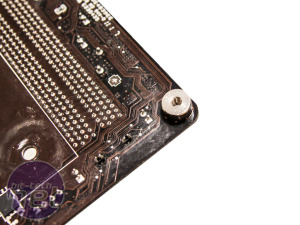

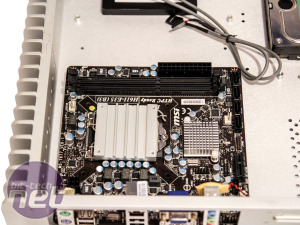

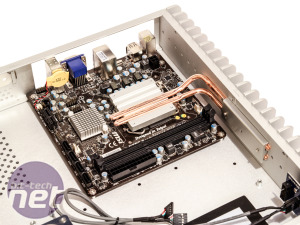
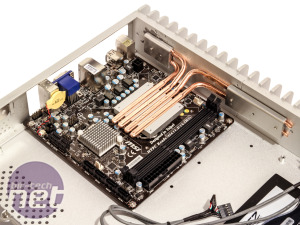
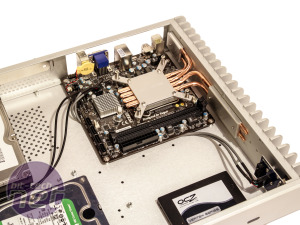
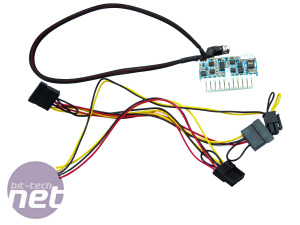
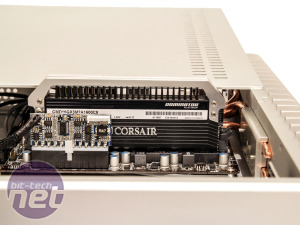
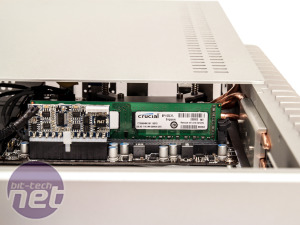
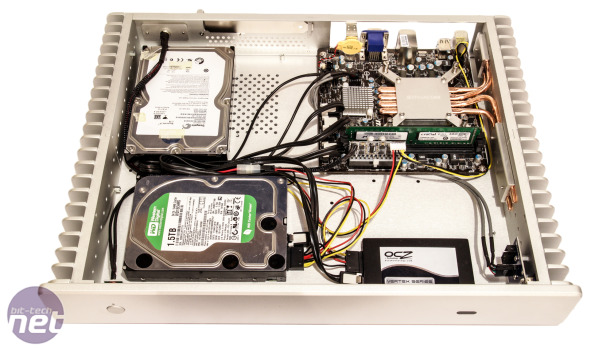







Want to comment? Please log in.